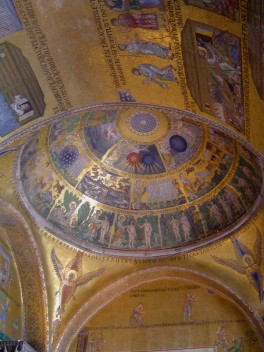Today BobTheScientist, scientist and blogger, tells us why Gould and Lewontin’s 1979 paper introducing ‘Spandrels’ to the study of evolution was such an important breakthrough for the field.

Doing a crossword the other day I was stymied for a while by “32 down. Intellectual.“ despite having some letters: E_G _._._D. I was annoyed, and not with myself, when the answer turned out to be ‘egghead’. In the English-speaking world, ‘Intellectual’ is sometimes, if not exactly a term of abuse, nevertheless not something to be proud of. When I left Europe for graduate school in Boston in January 1979, I suppose I was an intellectual, although I didn’t know it then and being British would have been ashamed of such a label. My project was at the interface between population genetics and history, but half of the necessary research was pursued on my own time: there was no mechanism for getting History credits towards my PhD in Biology. My pals on the ecology/ethology floor were smart and engaged, but ‘focused’.
At the very start of the following academic year, ‘Spandrels‘ (as the paper became popularly known) hit the floor with the crash of a Sevres tea-service being dropped. Gould and Lewontin, two would-be Marxist intellectuals from across the river at Harvard, set out to deconstruct a lot of what we evolutionary biologists took for granted. They did so with an awesome clatter of erudition: the word spandrels for a start, but also Pangloss, Bauplan, Aztecs and Tudors. ‘Spandrel‘ is an architectural word for the space between the tops of two adjacent arches and the ceiling, which Gould and Lewontin adopted to describe a characteristic that is a byproduct of the evolution of some other characteristic. Even my mother, a serious amateur in church architecture and the iconography of saints, didn’t know the word Spandrel – I asked.
Gould and Lewontin cited papers written in German and French by long-dead European scientists. It was an eye-opener for our group which had put in a serious request, ultimately disallowed, that competence in Fortran should be allowed to fulfill the language requirement to graduate from our University. But for all of us it was wonderful to see that being passionately engaged was an option: that we could at least consider kicking over the traces and thinking in a revolutionary way – it was, after all, only a decade since Sartre was on a Parisian barricade in the summer of 1968.
Thirty-five years on, Spandrels is a bit easier to read not least because today’s biologists now know about Baupläne. It’s a bit of a retrospective shock to see Gould and Lewontin’s fellow Harvard Professor E.O. Wilson coming in for some further uncollegiate sniping: as if washing their ideological linen in a public attack on Wilson and his Sociobiology: the New Synthesis (1975) in the New York Review of Books hadn’t been enough. All through the 1980s, I discussed this key paper with my Genetics students and every year one or two of them ‘got it’. The literature is still littered with the same sort of errors and woolly thinking that Gould and Lewontin identified and pilloried in 1979, so their Spandrels paper still has a place in the cycle of a graduate student journal club. Perhaps their strongest enduring message is that life in all its diversity and interactions is complex: too complex to be adequately explained by presenting some new data with a ribbon of plausible explanation tying it all together with a neat bow.
